The Impact of Cumulative Negative Air Temperature Degree-Days on the Appearance of Ice Cover on a River in Relation to Atmospheric Circulation
Abstract
:1. Introduction
2. Research Area, Data and Methods
- y—expected value of the dependent variable
- x—value of the independent variable
- exp—the exponential function, that is the exponential function with a basis equal to e, that is to the basis of the natural logarithm (exponent)
- b—regression coefficient
3. Results
3.1. Frequency of Negative Air Temperature Series
3.2. Circulatory Factors and Types of Atmospheric Circulation
3.3. Frequency of Days with Ice Cover on the River
3.4. Probability of Occurrence of Ice Cover
4. Discussion
5. Conclusions
Author Contributions
Funding
Acknowledgments
Conflicts of Interest
References
- Ustrnul, Z.; Czekierda, D.; Wypych, A. Extreme values of air temperature in Poland according to different atmospheric circulation classifications. Phys. Chem. Earth 2010, 35, 429–436. [Google Scholar] [CrossRef]
- Porębska, M.; Zdunek, M. Analysis of extreme temperature events in Central Europe related to high pressure blocking situations in 2001–2011. Meteorol. Z. 2013, 22, 533–540. [Google Scholar] [CrossRef]
- Tomczyk, A.M.; Bednorz, E. Heat and cold waves on the southern coast of the Baltic Sea. Baltica 2014, 27, 45–54. [Google Scholar] [CrossRef]
- Magnuson, J.J.; Robertson, D.M.; Benson, B.J.; Wynne, R.H.; Livingstone, D.M.; Arai, T.; Assel, R.A.; Barry, R.G.; Card, V.; Kuusisto, E.; et al. Historical trends in lake and river ice cover in the Northern Hemisphere. Science 2000, 289, 1743–1746. [Google Scholar] [CrossRef] [PubMed]
- Borsch, S.; Ginzburg, B.; Soldatova, I. Modeling the development of ice phenomena in rivers as applied to the assessment of probable changes in ice conditions at various scenarious of the future climate. Water Resour. 2001, 28, 194–200. [Google Scholar] [CrossRef]
- Prowse, T.D.; Bonsal, B.; Duguay, C.R.; Hessen, D.O.; Vuglinsky, V.S. River and Lake Ice. In Global Outlook for Ice & Snow; DEW/0924/NA; United Nations Environment Programme: Nairobi, Kenya, 2007; pp. 201–214. [Google Scholar]
- Takács, K.; Nagy, B.; Kern, Z. Human impacts on river ice regime in the Carpathian Basin. In Proceedings of the EGU General Assembly 2014, Vienna, Austria, 27 April–2 May 2014. [Google Scholar]
- Langan, S.J.; Johnston, L.; Donaghy, M.J.; Youngson, A.F.; Hay, D.W.; Soulsby, C. Variation in river water temperatures in an upland stream over a 30-year period. Sci. Total Environ. 2001, 265, 195–207. [Google Scholar] [CrossRef]
- Caissie, D.; St-Hilaire, A.; El-Jabi, N. Prediction of water temperatures using regression and stochastic models. In Proceedings of the 57th Canadian Water Resources Association Annual Congress, Montreal, QC, Canada, 16–18 June 2004; Canadian Water Resources Association: Ottawa, ON, Canada, 2004. [Google Scholar]
- Wiejaczka, Ł. Relationship between water temperature in the river and air temperature (on the Ropa River as an example). Folia Geogr. Geogr. Phys. 2007, 37–38, 95–105. (In Polish) [Google Scholar]
- Łaszewski, M.; Jeleński, P. A comparison of thermal conditions of the Raba River and the Świder River. Sci. Rev. Eng. Environ. Sci. 2013, 22, 239–248. [Google Scholar]
- Gorączko, M.; Pawłowski, B. Changing of ice phenomena on Warta River in vicinity of Uniejów. Biul. Uniejowski 2014, 3, 23–33. (In Polish) [Google Scholar]
- Graf, R. Variations of the thermal conditions of the Warta in the profile connecting the Urstromal and gorge sections of the valley (Nowa Wieś Podgórna–Śrem–Poznań). In Novel Methods and Solutions in Hydrology and Water Management; Absalon, D., Matysik, M., Ruman, M., Eds.; Hydrological Committee PTG, PTG Department Katowice: Katowice, Poland, 2015; pp. 177–194. (In Polish) [Google Scholar]
- Beltaos, S.; Prowse, T. River-ice hydrology in a shrinking cryosphere. Hydrol. Process. 2009, 23, 122–144. [Google Scholar] [CrossRef]
- Intergovernmental Panel on Climate Change (IPCC). Climate Change 2014: Synthesis Report; Contribution of Working Groups I, II and III to the Fifth Assessment Report of the Intergovernmental Panel on Climate Change; Intergovernmental Panel on Climate Change (IPCC): Geneva, Switzerland, 2014; Available online: https://www.ipcc.ch/pdf/assessment-report/ar5/syr/AR5_SYR_FINAL_SPM.pdf (accessed on 12 February 2018).
- United Nations Environment Programme (UNEP). United Nations Environment Programme, Annual Report. 2008. Available online: http://www.unep.org/PDF/AnnualReport/2008 (accessed on 20 January 2018).
- Slaymaker, O.; Kelly, R.E.J. The Cryosphere and Global Environmental Change; Wiley-Blackwell: Oxford, UK, 2006. [Google Scholar]
- Myglan, V.; Vaganow, E. Ice phenomena of the Middle Siberia Rivers for the period of the last 300 years (according to historical data) as a reflection of the climate change. J. Sib. Fed. Univ. Humanit. Soc. Sci. 2008, 1, 361–372. [Google Scholar]
- Šarauskiené, D.; Jurgelénaité, A. Impact of climate change on river ice phenology in Lithuania. Environ. Res. Eng. Manag. 2008, 4, 13–22. [Google Scholar]
- Richard, M.; Morse, B.; Daly, S.F. Modelling frazil ice growth in the St. Lawrence River. Can. J. Civ. Eng. 2015, 42, 592–608. [Google Scholar] [CrossRef]
- European Economic Area (EEA). Report No. 12/2012, Climate Change, Impacts and Vulnerability in Europe 2012. 2012. Available online: http://www.eea.europa.eu/pl/themes (accessed on 20 January 2018).
- Agafonova, S.А.; Frolova, N.L. Features of ice regime of Northern Dvina rivers’ basin. Water Resour. J. 2007, 34, 123–131. [Google Scholar] [CrossRef]
- Klavins, M.; Briede, A.; Rodinovs, V. Ice regime of rivers in Latvia in relation to climatic variability and North Atlantic oscillation. In Climate Change in Latvia; Klavins, M., Ed.; University of Latvia: Riga, Latvia, 2007; pp. 58–72. [Google Scholar]
- Choiński, A.; Kolendowicz, L.; Pociask-Karteczka, J. Ice cover on Lake Morskie Oko response to the air temperature and air circulation patterns in 1971–2010. Nauka a Zarządzanie Obszarem Tatr i Ich Otoczeniem 2010, 1, 41–46. (In Polish) [Google Scholar]
- Kędziora, A.; Kępińska-Kasprzak, M.; Kowalczak, P.; Kundzewicz, Z.W.; Miler, A.T.; Pierzgalski, E.; Tokarczyk, T. Water shortage-related threats. Gospod. Wodna 2014, 10, 373–376. (In Polish) [Google Scholar]
- Styszyńska, A.; Marsz, A. Mechanisms of atmospheric climate change—The problem of modern warming. In Energy of the Future, Energy Saving Installations and Systems; Kwiatkowski, Z.R., Ed.; INFOTECH: Gdańsk, Poland, 2015; p. 17. (In Polish) [Google Scholar]
- Boryczka, J.; Stopa-Boryczka, M. Cyclic temperature and precipitation fluctuations in Poland in 19th–2st century. Acta Agrophys. 2004, 3, 21–33. (In Polish) [Google Scholar]
- Kożuchowski, K.; Żmudzka, E. Warming in Poland: Scale and seasonal distribution in changes of air temperature in the second half of 20th century. Przegląd Geofizyczny 2001, 46, 81–90. (In Polish) [Google Scholar]
- Michalska, B. Tendencies of air temperature changes in Poland. Prace i Studia Geograficzne 2011, 47, 67–75. (In Polish) [Google Scholar]
- Kundzewicz, Z.W. Climate changes, their reasons and effects—Observations and projections. Landf. Anal. 2011, 15, 39–49. [Google Scholar]
- Przybylak, R. Changes in Poland’s climate over the last millenium. Czas. Geogr. 2011, 82, 23–48. (In Polish) [Google Scholar]
- Yoo, J.; D’Odorico, P. Trends and fluctuations in the dates of ice break-up of lakes and rivers in Northern Europe: The effect of the North Atlantic. J. Hydrol. 2002, 268, 100–112. [Google Scholar] [CrossRef]
- Ćmielewski, M. The freezing variability of the northern hemisphere rivers in the XX century. In Abstracts of Lectures; II Workshops: Ice problems of the rivers “Congestion and high water jam”; Nicolaus Copernicus University: Toruń, Poland, 2010; pp. 16–17. (In Polish) [Google Scholar]
- Jania, J. Consequences of global warming for the cryosphere. Nauka 2008, 3, 35–58. (In Polish) [Google Scholar]
- Prowse, T.D.; Alfredsen, K.; Beltaos, S.; Bonsal, B.R.; Bowden, W.B.; Duguay, C.R.; Korhola, A.; McNamara, J.; Vincent, W.F.; Vuglinsky, V.; et al. Effects of changes in arctic lake and river ice. Ambio 2011, 40, 63–74. [Google Scholar] [CrossRef]
- Hattermann, F.F.; Kundzewicz, Z.W.; Huang, S.; Vetter, T.; Gerstengarbe, F.-W.; Werner, P.C. Climatological drivers of changes in flood hazard in Germany. Acta Geophys. 2013, 61, 463–477. [Google Scholar] [CrossRef]
- Chu, T.; Das, A.; Lindenschmidt, K.E. Monitoring the variation in ice-cover characteristics of the Slave River, Canada using RADARSAT-2 data. Remote Sens. 2015, 7, 13664–13691. [Google Scholar] [CrossRef]
- Kuusisto, E.; Elo, A.R. Lake and river ice variables as climate indicators in Northern Europe. Int. Ver. Theor. Angew. Limnol. Verh. 1998, 27, 2761–2764. [Google Scholar] [CrossRef]
- Cheng, B.; Vihma, T.; Launiainen, J. Modelling of the superimposed ice formation and sub-surface melting in the Baltic Sea. Geophysica 2003, 39, 31–50. [Google Scholar]
- Frauenfeld, O.W.; Zhang, T.; McCreight, J.L. Northern hemisphere freezing/thawing index variations over the twentieth century. Int. J. Climatol. 2007, 27, 47–63. [Google Scholar] [CrossRef]
- Ruosteenoja, K. The date of break-up of lake ice as a climatic index. Geophysica 1986, 22, 89–99. [Google Scholar]
- Livingstone, D.M. Break-up dates of alpine lakes as proxy data for local and regional mean surface air temperatures. Clim. Chang. 1997, 37, 407–439. [Google Scholar] [CrossRef]
- Dibike, Y.; Prowse, T.; Saloranta, T.; Ahmed, R. Response of Northern hemisphere lake-ice cover and lake-water thermal structure patterns to a changing climate. Hydrol. Process. 2011, 25, 2942–2953. [Google Scholar] [CrossRef]
- Lindenschmidt, K.E.; Sydor, M.; Carson, R.W.; Harrison, R. Ice jam modelling of the Lower Red River. J. Water Resour. 2012, 4, 16739. [Google Scholar] [CrossRef]
- Das, A.; Sagin, J.; Van der Sanden, J.; Evans, E.; McKay, K.; Lindenschmidt, K.E. Monitoring the freeze-up and ice cover progression of the Slave River. Can. J. Civ. Eng. 2015, 42, 609–621. [Google Scholar] [CrossRef]
- Zhang, F.; Mosaffa, M.; Chu, T.; Lindenschmidt, K.E. Using Remote Sensing Data to Parameterize Ice Jam Modeling for a Northern Inland Delta. Water 2017, 9, 306. [Google Scholar] [CrossRef]
- Mroziński, Ł. Perennial variability of the Lower Vistula freezing. Gaz. Obs. IMGW 2006, 2, 28–31. (In Polish) [Google Scholar]
- Majewski, W.; Mroziński, Ł. Ice phenomena on the Lower Vistula. Gospod. Wodna 2010, 1, 18–22. (In Polish) [Google Scholar]
- Kondracki, J. Regional Geography of Poland; Scientific Publishing House PWN: Warsaw, Poland, 2008. (In Polish) [Google Scholar]
- Woś, A. The Climate of Poland in the Second Half of the 20th Century; Scientific Publishing House UAM: Poznan, Poland, 2010. (In Polish) [Google Scholar]
- Borowicz, J. An Analysis of River Ice Formation in the Noteć and Its Right-Bank Tributaries in the Years 1982–2011. Master’s Thesis, Adam Mickiewicz University, Poznan, Poland, 2016. (In Polish). [Google Scholar]
- ETC/ICM. European Freshwater Ecosystem Assessment: Cross Walk between the Water Framework Directive and Habitats Directive Types, Status and Pressures, Technical Report 2/2015, Magdeburg: European Topic Centre on Inland, Coastal and Marine Waters. 2015. Available online: http://icm.eionet.europa.eu (accessed on 20 January 2018).
- Ward, J.H. Hierarchical grouping to optimize an objective function. J. Am. Stat. Assoc. 1963, 58, 236–244. [Google Scholar] [CrossRef]
- Esteban, P.; Jones, P.D.; Martin-Vide, J.; Mases, M. Atmospheric circulation patterns related to heavy snowfall days in Andorra, Pyrenees. Int. J. Climatol. 2005, 25, 319–329. [Google Scholar] [CrossRef]
- Faraway, J.J. Extending the Linear Model with R: Generalized Linear, Mixed Effects and Nonparametric Regression Models, Texts in Statistical Science; Chapman & Hall/CRC: London, UK, 2006; Available online: http://www.taylorandfrancis.com (accessed on 12 February 2018).
- R Core Team. R: A Language and Environment for Statistical Computing; R Foundation for Statistical Computing: Vienna, Austria, 2015; Available online: http://www.R-project.org (accessed on 12 February 2018).
- Biecek, P. A Guide to the R Package; GIS Publishing House: Wrocław, Poland, 2008; Available online: http://www.gis.wroc.pl (accessed on 20 January 2018). (In Polish)
- Marsz, A.A. Thermal Status of the North Atlantic and Thermal Regime of Winters on the Polish Coast of the Baltic Sea; WSM: Gdynia, Poland, 2001. (In Polish) [Google Scholar]
- Thompson, D.W.J.; Wallace, J.M. Annular modes in the extratropical circulation. Part I: Month-to-month variability. J. Clim. 2000, 13, 1000–1016. [Google Scholar] [CrossRef]
- Degirmendžić, J.; Kożuchowski, K.; Żmudzka, E. Circulation requirements of the air temperature variations in Poland in the period 1951–2000. Prz. Geof. 2002, 47, 293–298. (In Polish) [Google Scholar]
- Kryjov, V.N. Searching for circulation patterns affecting North Europe annual temperature. Atmos. Sci. Lett. 2004, 5, 23–34. [Google Scholar] [CrossRef]
- Marsz, A.A. On the Oceanic Conditions of the Circular and Thermal Nature of Winter in Poland and Central Europe; Publishing House of the Maritime Academy: Gdynia, Poland, 2005. (In Polish) [Google Scholar]
- Bączyk, A.; Suchożebrski, J. Variability of ice phenomena on the Bug River (1903–2012). Inżynieria Ekologiczna 2016, 49, 136–142. (In Polish) [Google Scholar] [CrossRef]
- Pawłowski, B.; Gorączko, M.; Szczerbińska, A. Ice phenomena on the rivers of Poland. In Hydrology of the Poland; Jokiel, P., Marszelewski, W., Pociask-Karteczka, J., Eds.; Scientific Publishing House PWN: Warsaw, Poland, 2017; pp. 195–200. (In Polish) [Google Scholar]
- Cowx, I. Innovations in Fish Passage Technology. Fish. Manag. Ecol. 2000, 7, 471–472. [Google Scholar] [CrossRef]
- Westhoff, J.T.; Paukert, C.P. Climate change simulations predict altered biotic response in a thermally heterogeneous stream system. PLoS ONE 2014, 9, e111438. [Google Scholar] [CrossRef] [PubMed]
- Caissie, D. The thermal regime of rivers: A review. Freshw. Biol. 2006, 51, 1389–1406. [Google Scholar] [CrossRef]
- Poole, C.; Berman, C.H. An Ecological Perspective on In-Stream Temperature: Natural Heat Dynamics and Mechanisms of Human-Caused Thermal Degradation. Environ. Manag. 2001, 27, 787–802. [Google Scholar] [CrossRef]
- Kanno, Y.; Vokoun, J.C.; Letcher, B.H. Paired stream–air temperature measurements reveal fine-scale thermal heterogeneity within headwater brook trout stream networks. River Res. Appl. 2014, 30, 745–755. [Google Scholar] [CrossRef]
- Snyder, C.; Hitt, N.; Young, J. Accounting for groundwater in stream fish thermal habitat responses to climate change. Ecol. Appl. 2015, 25, 1397–1419. [Google Scholar] [CrossRef] [PubMed]
- Ćmielewski, M.; Grześ, M. Perennial variability of the Vistula freezing process in Toruń and Niemen in Smolniki in the 19th and 20th centuries. Gospod. Wodna 2010, 3, 112–115. (In Polish) [Google Scholar]
- Johnson, S.L.; Jones, J.A. Stream temperature response to forest harvest and debris flows in western Cascades, Oregon. Can. J. Fish. Aquat. Sci. 2000, 57, 30–39. [Google Scholar] [CrossRef]
- Lowney, C.L. Stream temperature variation in regulated rivers: Evidence for a spatial pattern in daily minimum and maximum magnitudes. Water Resour. Res. 2000, 36, 2947–2955. [Google Scholar] [CrossRef]
- Younus, M.; Hondzo, M.; Engel, B.A. Stream temperature dynamics in upland agricultural watersheds. J. Environ. Eng. 2000, 126, 518–526. [Google Scholar] [CrossRef]
- Water Framework Directive (WFD). Directive 2000/60/EC of the European Parliament and of the Council Establishing a Framework for the Community Action in the Field of Water Policy. 2000. Available online: http://ec.europa.eu/environment/water/water-framework (accessed on 20 January 2018).
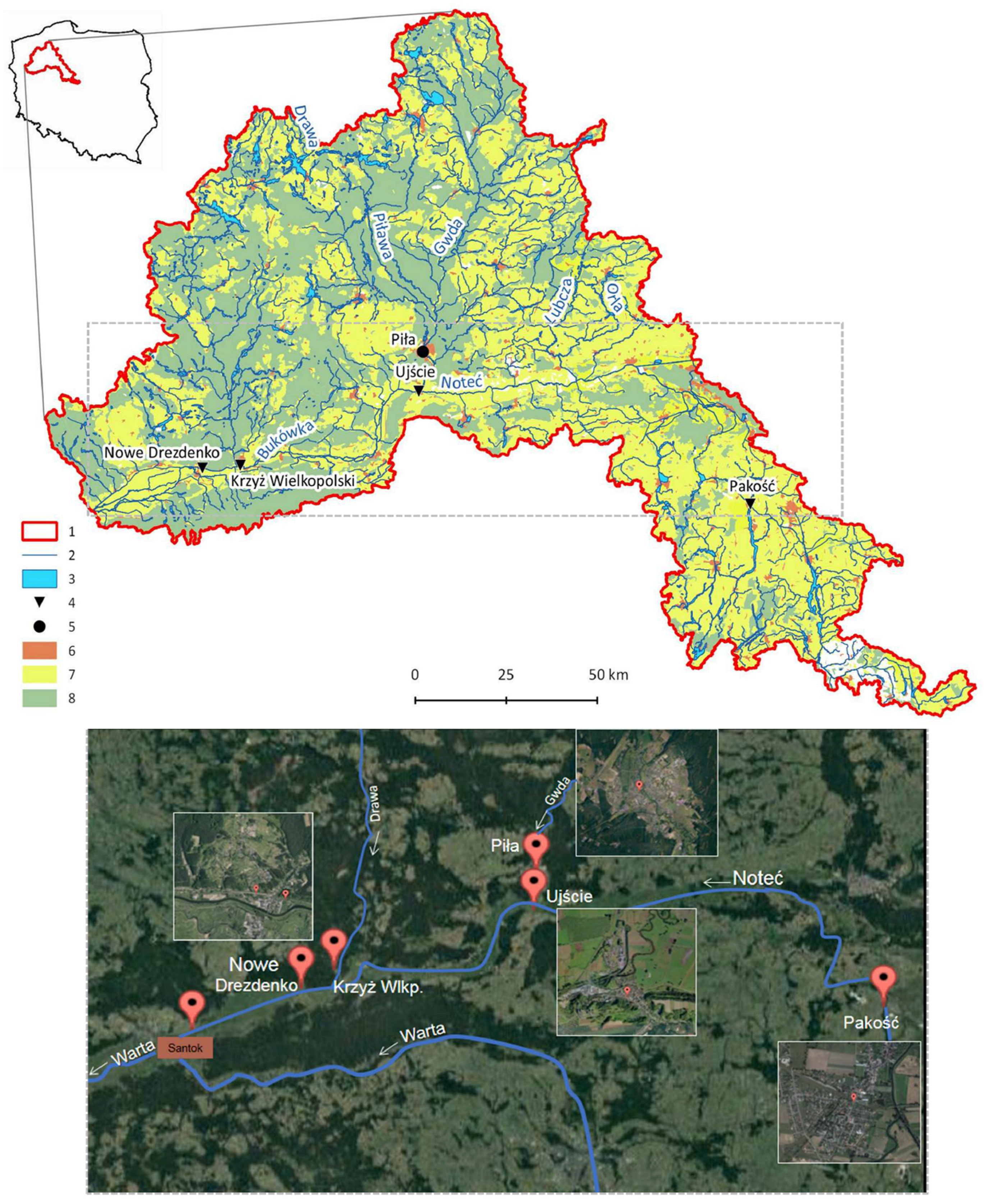



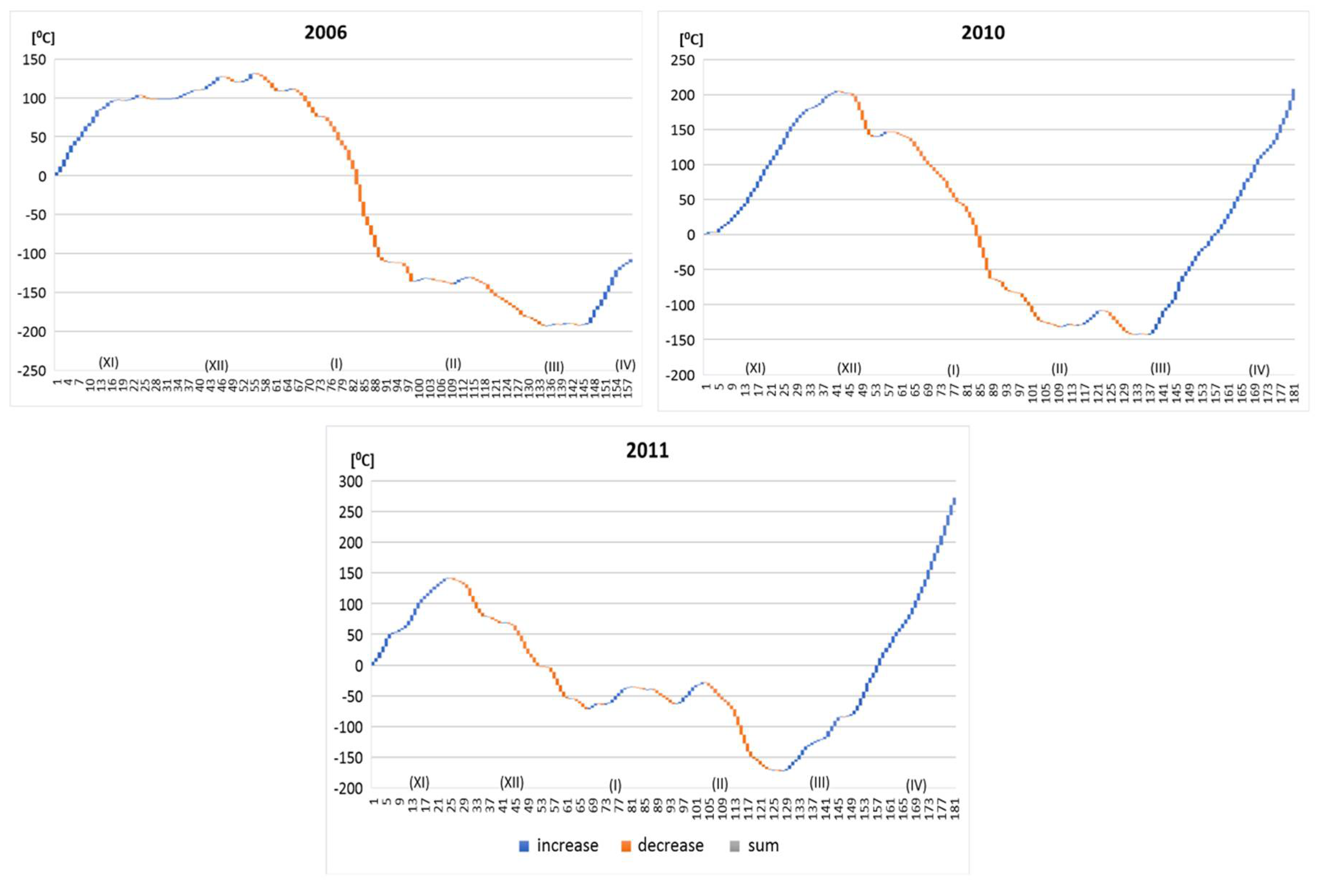
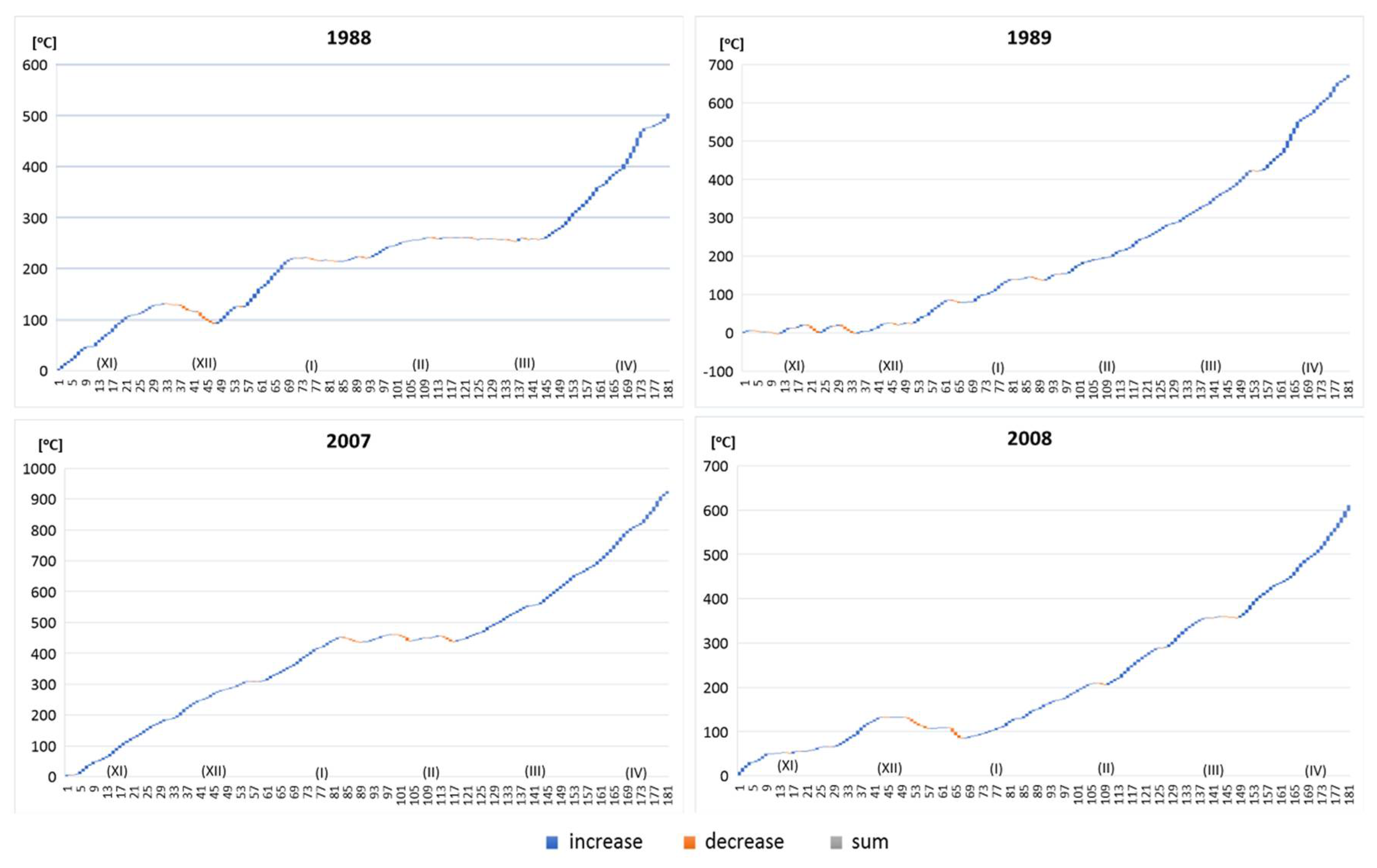


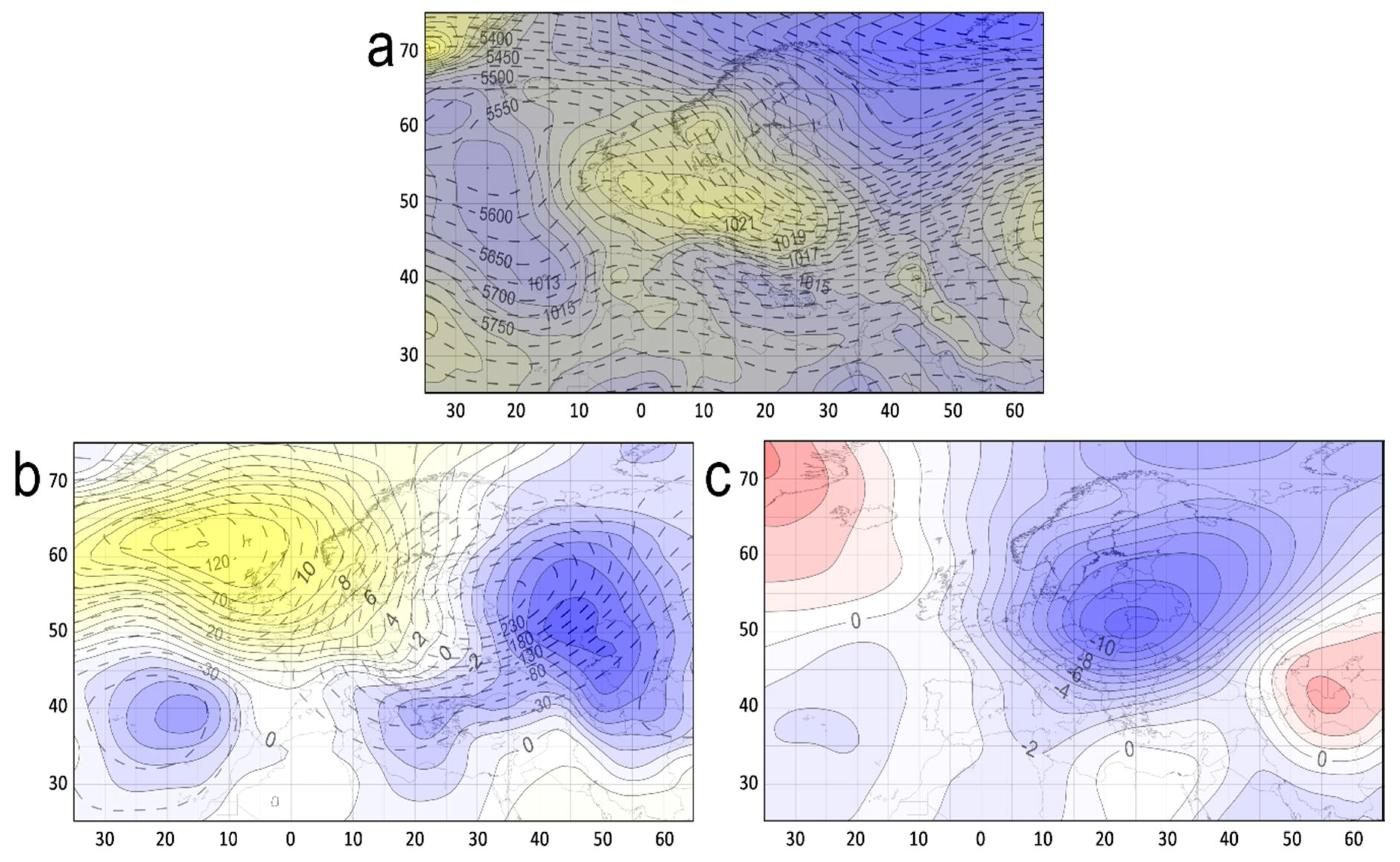

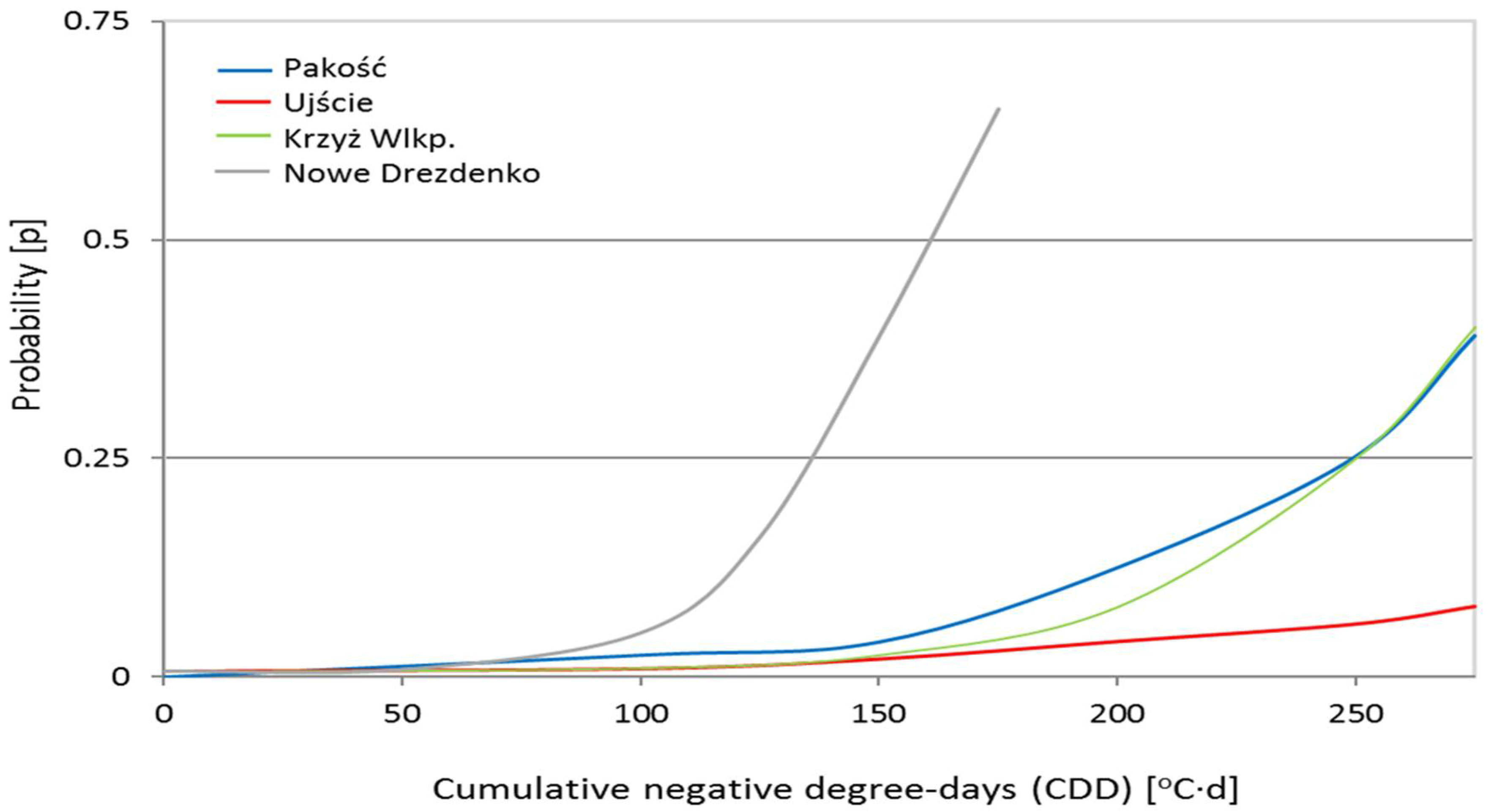

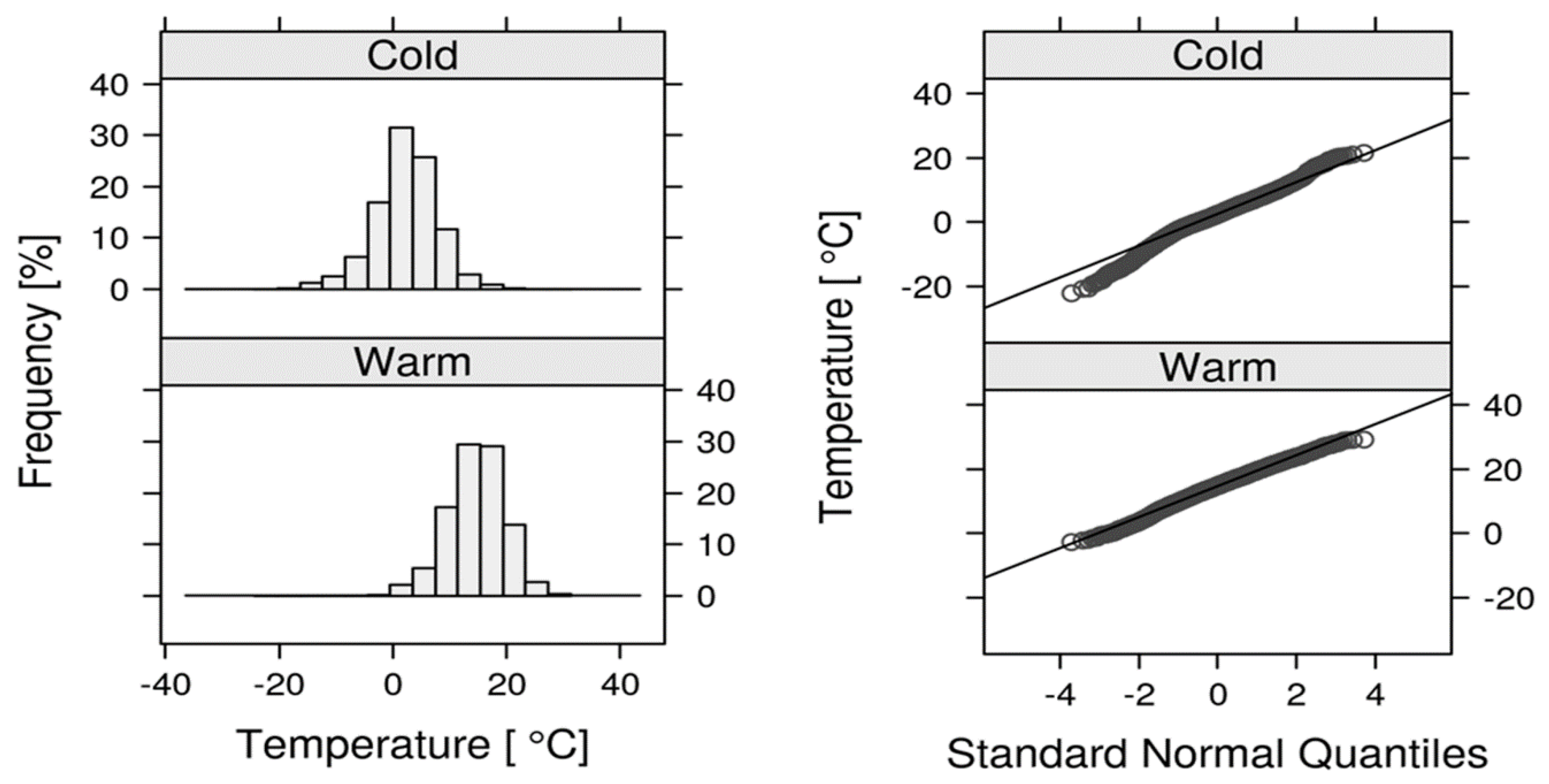
| Station | Coefficients | b* | LL | UL | p |
|---|---|---|---|---|---|
| Pakość | Intercept | −6.367 | −6.878 | −5.928 | 5.5 × 10−154 |
| CDD—explanatory variable | 0.0207 | 0.0140 | 0.0266 | 2.13 × 10−11 | |
| Ujście | Intercept | −7.328 | −8.196 | −6.649 | 3.93 × 10−79 |
| CDD—explanatory variable | 0.0167 | 0.0082 | 0.0232 | 3.92 × 10−6 | |
| Krzyż | Intercept | −7.862 | −8.984 | −7.030 | 2.31 × 10−58 |
| CDD—explanatory variable | 0.0267 | 0.0203 | 0.0332 | 6.71 × 10−17 | |
| Nowe Drezdenko | Intercept CDD—explanatory variable | −8.436 0.0545 | −9.892 0.0438 | −7.406 0.0676 | 2.21 × 10−42 3.58 × 10−20 |
| Year | Total Sum of CDD | Total Duration | Mean Degree of Increase in CDD | Maximum CDD | Maximum Duration | Maximum Degree |
|---|---|---|---|---|---|---|
| 1988 | 5.1 | 4 | 1.275 | 3.7 | 2 | 1.85 |
| 1991 | 0.4 | 1 | 0.400 | 0.4 | 1 | 0.40 |
| 1992 | 0.3 | 1 | 0.300 | 0.3 | 1 | 0.30 |
| 1997 | 1.3 | 3 | 0.425 | 0.9 | 2 | 0.45 |
| 2003 | 6.5 | 4 | 1.550 | 5.1 | 3 | 1.70 |
| 2009 | 0.1 | 1 | 0.100 | 0.1 | 1 | 0.10 |
| 2012 | 0.5 | 1 | 0.500 | 0.5 | 1 | 0.50 |
| Statistics | Pakość | Ujście | Krzyż Wlkp. | Nowe Drezdenko |
|---|---|---|---|---|
| Min | 0.0 | 0.0 | 0.0 | −42.9 |
| Q1 * | −16.6 | −21.5 | −92.6 | −73.5 |
| Median | −37.6 | −27.4 | −129.0 | −96.0 |
| Mean | −37.8 | −56.0 | −122.0 | −99.5 |
| Q3 | −48.1 | −37.8 | −153.0 | −129.0 |
| Max | −135.0 | −198.0 | −246.0 | −166.0 |
| Pakość | Ujście | Krzyż Wlkp. | Nowe Drezdenko | ||||
|---|---|---|---|---|---|---|---|
| First | Last | First | Last | First | Last | First | Last |
| 1987-01-10 | 1987-01-22 | 1987-01-17 | 1987-02-15 | 1987-01-12 | 1987-03-15 | 1987-01-11 | 1987-03-16 |
| 1991-02-05 | 1991-02-11 | 1989-12-03 | 1989-12-04 | 1996-02-13 | 1996-02-29 | 1993-01-04 | 1993-01-08 |
| 1993-12-26 | 1993-01-08 | 1990-01-05 | 1990-01-08 | 1997-11-30 | 1997-12-31 | 1996-01-03 | 1996-03-08 |
| 1996-02-01 | 1996-02-15 | 1994-02-15 | 1994-02-18 | 2003-01-08 | 2003-01-16 | 1997-12-31 | 1997-02-09 |
| 1997-12-24 | 1997-01-20 | 1998-12-18 | 1998-12-22 | 2006-01-24 | 2006-02-11 | 2003-01-08 | 2003-01-16 |
| 1998-12-18 | 1998-12-26 | 2002-12-23 | 2002-01-20 | 2010-01-24 | 2010-02-13 | 2006-01-24 | 2006-02-11 |
| 2000-01-23 | 2000-01-25 | 2006-01-01 | 2006-02-02 | 2011-03-01 | 2011-03-05 | 2010-01-24 | 2010-02-17 |
| 2003-12-10 | 2003-01-12 | 2008-01-05 | 2008-01-10 | 2012-02-08 | 2012-02-21 | 2011-12-04 | 2011-03-06 |
| 2004-12-26 | 2004-02-25 | 2012-02-08 | 2012-02-20 | ||||
| 2006-01-08 | 2006-01-31 | ||||||
| 2008-01-05 | 2008-01-07 | ||||||
| 2009-01-01 | 2009-01-18 | ||||||
| 2010-12-21 | 2010-02-13 | ||||||
| 2011-12-18 | 2011-12-22 | ||||||
| 2012-01-28 | 2012-02-22 | ||||||
| Statistics | Pakość | Ujście | Krzyż Wlkp. | Nowe Drezdenko |
|---|---|---|---|---|
| Min | 1 | 1 | 5 | 5 |
| Q1 * | 5 | 4 | 10 | 10 |
| Median | 11 | 5 | 17 | 15 |
| Mean | 12 | 10 | 17 | 20 |
| Q3 | 16 | 9 | 21 | 25 |
| Max | 31 | 30 | 33 | 44 |
© 2018 by the authors. Licensee MDPI, Basel, Switzerland. This article is an open access article distributed under the terms and conditions of the Creative Commons Attribution (CC BY) license (http://creativecommons.org/licenses/by/4.0/).
Share and Cite
Graf, R.; Tomczyk, A.M. The Impact of Cumulative Negative Air Temperature Degree-Days on the Appearance of Ice Cover on a River in Relation to Atmospheric Circulation. Atmosphere 2018, 9, 204. https://doi.org/10.3390/atmos9060204
Graf R, Tomczyk AM. The Impact of Cumulative Negative Air Temperature Degree-Days on the Appearance of Ice Cover on a River in Relation to Atmospheric Circulation. Atmosphere. 2018; 9(6):204. https://doi.org/10.3390/atmos9060204
Chicago/Turabian StyleGraf, Renata, and Arkadiusz Marek Tomczyk. 2018. "The Impact of Cumulative Negative Air Temperature Degree-Days on the Appearance of Ice Cover on a River in Relation to Atmospheric Circulation" Atmosphere 9, no. 6: 204. https://doi.org/10.3390/atmos9060204





